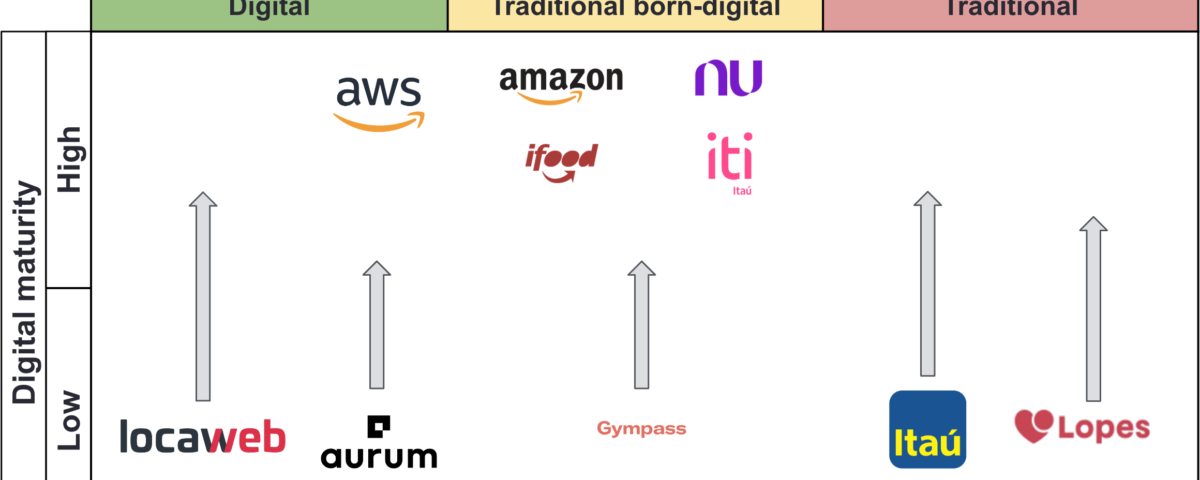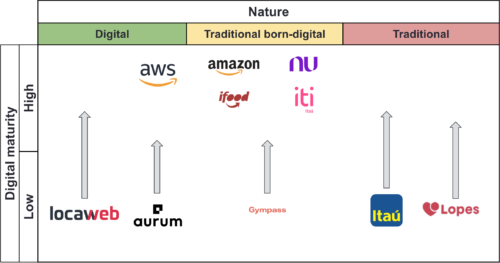Short answer is YES!
The fact that a company is a technology company, that is, a company whose product is the software or technology developed by the product development team, does not necessarily imply that the company has digital maturity.
Having digital maturity means having a digital product culture where the company applies the 4 principles that allow it to develop successful digital products:
- Fast and frequent deliveries: you can’t want to innovate and make new products by making monthly or quarterly deliveries of code.
- Focus on the problem: understand the problem well and only then think about possible solutions. Test different hypotheses to see which solves better and faster.
- Delivering results: what a product development team has to deliver are results. Product, app, feature, algorithm are not the goal, they are means to deliver results.
- Ecosystem mentality: it’s the focus on the customer, only with a boost. Every company has more than one customer, and you need to understand these different types of customers and their relationships.
To illustrate the need for digital transformation even in technology companies, I will give 3 examples:
Locaweb
When I joined Locaweb in 2005, the company had around 100 people and the product development team had around 30 people, which is a good size. However, product development was done in a very old way, in a cascade, based on ideas from C-levels and sales orders, without talking to the customer.
I remember filling out a PRD (_Product Requirement Document_) with all the requirements for a new product we plan to release based on the ideas from the C-levels. After filling in all the details, which took me 2 months to do, I delivered a document of more than 25 pages to engineering, full of details about the product. Engineering took 5 months to deliver the finished product. During that time, whenever I asked how development was going, the answer I got was that development was going as planned and that they were strictly following the PRD. When it was ready, I went to test the product and found that an expected functionality was not there. I checked the PRD to see if I had forgotten to include that specific functionality, but no, I hadn’t, it was there. So, talking to the engineers, they looked at the documentation, they didn’t understand all the details of the functionality and, due to the rush to deliver, they decided not to include the functionality.
Through this example, it is very clear that our digital maturity at that time was very low. We managed to evolve and increase our digital maturity over the years, but this is a good example of a digital company, whose product sold by the company is the software or technology developed by the product development team, but with low digital maturity that has been improving over the years. of years.
Aurum
This is the company of 2 good college friends. They formed around 1990 and, at the time, created a product to help lawyers in their day-to-day lives. Like all software in the 1990s, it was _on-premise_ software, to be installed on each attorney’s computer.
Later, they released a client-server version where lawyers could exchange information through the system, and the work performed by each lawyer was stored on a local server.
Around 2010 they started to realize the need to migrate to the cloud and I helped them with one of my first consulting jobs. The big dilemma they faced was: how to put in the cloud version everything that was created over 20 years of work in the client-server version? It would certainly take a long time and, most likely, the customer would not perceive any value, that is, he would not pay extra for this new software. Aurum would invest a lot of money to make new software that would do the same as the client-server version, and it would not be able to overcharge its customers to get a return on that investment. What to do?
They took two simultaneous paths that are both great strategies for similar cases:
- new segment: doing web development from scratch, that was the decision that Aurum took in 2010 and that gave rise to Astrea. While Aurum’s core product was a mature product, focused on large law firms and legal departments of large companies, Astrea was aimed at small law firms and self-employed lawyers, who did not need all the complexity of Themis. This allowed creating a simple minimal version to be launched for a segment very close to the segment they already operated, but without needing to have all the complexity that their mature product already had.
- strangler pattern: it offers an incremental, reliable process for refactoring code. It describes a method whereby a new system slowly grows over the top of an old system until the old system is “strangled” and can simply be removed. So while a team was experimenting with the new product for the new segment, Astrea, the cash cow product, Themis, had to be modernized. This was done using the legacy bottleneck strategy, which means gradually moving pieces of product from old technology to more modern technology. The prioritization of which piece to move should be driven primarily by business and user needs. Whenever there is a need to implement something in the legacy due to a business need or to solve a customer problem, this is an excellent opportunity to implement this out of the legacy, in a more modern system architecture. Over the years it is possible to reduce the legacy substantially until eventually it ceases to exist. In the case of Aurum, this Themis modernization process lasted almost 20 years. In 2005 they started the web version so that lawyers could access the same data they used in the office while traveling or even at home.
It is important to note that both strategies have the value generated for the business and for the customer as a guiding principle of prioritization. It is not the technical need that guided the decisions, but the business and customer needs. The focus is on generating business and customer value and taking the opportunity to update technology.
In building Astrea, the priority was to serve a new market segment, small offices and self-employed professionals, and in doing so, learn from cloud product development technology. With that, a new income line was created.
In bottlenecking the desktop version of Themis, the goal has always been to monitor and anticipate customer needs, allowing customers to access their data from anywhere, thus increasing customer engagement and retention.
If you want to dig deeper into their digital transformation journey, check out this interview (AI translated).
Aurum is another good example of a digital company, whose product sold by the company is the software or technology developed by the product development team, but with low digital maturity that has improved over time.
Gympass
When I joined Gympass, in mid-2018, the company already had 800 employees and was present in 14 countries. However, its entire product development team, including engineers, product designers, and product managers, was only 30 people, meaning less than 4% of the company was focused on product development. The impact of this very small team in relation to the size of the company was that, at that time, many of the day-to-day tasks with customers and partners had to be performed manually.
For this reason, Gympass had a huge operations team to handle all these manual tasks. The more I sold, the more people were needed on the operations team. And the app was still a webview version.
The C-level and board recognized the need to invest in digital to scale the company, and this team grew considerably to around 250 people, who automated many of the manual operations tasks and delivered and evolved a fully native application.
This is an interesting example of a traditional born-digital company, which sells a corporate benefit to its customers so that they can offer their employees access to a network of tens of thousands of gyms and studios, and which had a low digital maturity. This typically happens when the founders of a traditional born-digital company that is using digital to improve a traditional business have little or no prior experience with digital products. If they don’t bring some people with that experience into the founding team, chances are good that the digital maturity of that company is low.
Nature of the enterprise vs digital maturity
When we evaluate a company from the point of view of the use of digital technologies, we must think in two dimensions. On the X axis we think about the nature of the company, whether it is digital, traditional or born-digital traditional, and on the Y axis we assess its digital maturity, as shown in the image below:
How to improve your company’s digital maturity?
This is an excellent question and the motivation I have for writing my fourth book, helping people increase the digital maturity of their companies. I already have 2/3 of the book ready. This article is even part of the book! (=
Workshops, coaching, and advisory services
I’ve been helping companies and their leaders (CPOs, heads of product, CTOs, CEOs, tech founders, and heads of digital transformation) bridge the gap between business and technology through workshops, coaching, and advisory services on product management and digital transformation.
Newsletter
I write regularly about product management, product development, digital product leadership, and digital transformation. You can receive a notification whenever I publish a new article without depending on any social network algorithms to notify you! Just subscribe to my newsletter.
Digital Product Management Books
Do you work with digital products? Do you want to know more about managing a digital product to increase its chances of success, solve its user’s problems and achieve the company objectives? Check out my Digital Product Management bundle with my 3 books, where I share what I learned during my 30+ years of experience in creating and managing digital products:
- Startup Guide: How startups and established companies can create profitable digital products
- Product Management: How to increase the chances of success of your digital product
- Leading Product Development: The art and science of managing product teams
You can also acquire the books individually by clicking on their titles above.





